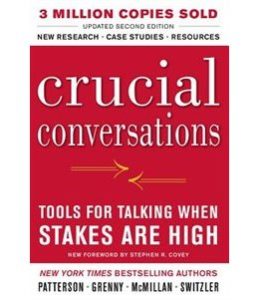 Crucial Conversations: Tools for talking when the stakes are high by Kerry Patterson, Joseph Grenny, Ron McMillan, Al Switzler.
Crucial Conversations: Tools for talking when the stakes are high by Kerry Patterson, Joseph Grenny, Ron McMillan, Al Switzler.
Reviewed by: Glain Roberts-McCabe
The Premise: A crucial conversation is one where the stakes are high, differences of opinions exist and emotions run deep. If you can master the art of crucial conversations, you will (according to the authors) kick-start your career, strengthen your relationships and improve your health. They back up it up by outlining the key ways you can improve dialog by following the steps of: staying focused, learning to watch for cues, increasing “safety” and staying committed to finding common ground.
The books principles are broken down step by step with opportunities to do some self-analysis and practice along the way. The book is filled with relatable examples from both work and home that make it easy to follow. The final chapter offers an array of “tough case” scenarios from insubordination to dealing with someone with a personal hygiene issue which reinforce their overarching thesis that any conversation – no matter how tricky – can be dealt with constructively.
The Bottom-line: Crucial Conversations is a management toolkit staple. We’ve all been in these discussions (sometimes several times a day) and, no matter how much you detest or enjoy this type of dialog, this book will certainly help you add some tools to your leadership kit bag. I have to start by coming clean and say that I am exceptionally adept at conflict avoidance so, personally, I found this book to be hugely useful. There are so many examples and scenarios that you can actually develop a new language for tackling the “tough stuff” as you read through it (love instant application!). Some people may not enjoy the use of personal as well as business examples, but, if you like your professional development to do “double duty” this book will help you with tough conversations on the job and on the home-front too. The concept of creating a “safe” space for others to discuss hot bed issues is especially useful if you’re prone to getting caught up in the emotion of situations.
What would have boosted the books effectiveness for me would have been to have their overarching visual model presented earlier in the book (vs. Chapter 10) to tie the various tools and techniques together. I found myself flipping back to previous chapters to get my bearings.
Roundtable Rating: Strongly recommended. A must for anyone who would like to get better at handling challenging discussions in a productive way.
Readability Factor: Easy to read, but if you’re visual flip to Chapter 10 to see the full concept overview before proceeding in the book. Check out the book here.


